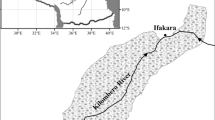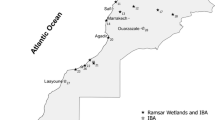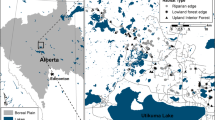Abstract
Floodplain and riparian ecosystems have cooler, wetter microclimatic conditions, higher water availability and greater vegetation biomass than adjacent terrestrial zones. Given these conditions, we investigated whether floodplain ecosystems allow terrestrial bird species to extend into more arid regions than they otherwise would be expected to occupy. We evaluated associations between aridity and the occurrence of 130 species using bird survey data from 2998 sites along the two major river corridors in the Murray–Darling Basin, Australia. We compared the effects of aridity on species occurrence in non-floodplain and floodplain ecosystems to test whether floodplains moderate the effect of aridity. Aridity had a negative effect on the occurrence of 58 species (45%) in non-floodplain ecosystems, especially species dependent on forest and woodland habitats. Of these 58 species, the negative effects of aridity were moderated in floodplain ecosystems for 22 (38%) species: 12 showed no association with aridity in floodplain ecosystems and the adverse effects of aridity on species occurrence were less pronounced in floodplain ecosystems compared to non-floodplain ecosystems for ten species. Greater vegetation greenness indicated that floodplain vegetation was more productive than vegetation in non-floodplain ecosystems. Floodplain ecosystems allow many terrestrial species to occur in more arid regions than they otherwise would be expected to occupy. This may be due to higher vegetation productivity, cooler microclimates or connectivity of floodplain vegetation. Although floodplain and riparian ecosystems will become increasingly important for terrestrial species persistence as climate change increases drying in many parts of the world, many are also likely to be highly affected by reduced water availability.




Similar content being viewed by others
REFERENCES
Atlas of Living Australia and Bureau of Rural Sciences. 2015. Normalised difference vegetation index (NDVI*100). Australia: Atlas of Living Australia.
Ballinger A, Lake PS. 2006. Energy and nutrient fluxes from rivers and streams into terrestrial food webs. Mar Freshw Res 57:15–28.
Barrett G, Silcocks A, Barry S, Cunningham R, Poulter R. 2003. The new atlas of Australian birds. Hawthorn East, (VCT): Birds Australia (Royal Australasian Ornithologists Union).
Bennett AF, Nimmo DG, Radford JQ. 2014. Riparian vegetation has disproportionate benefits for landscape-scale conservation of woodland birds in highly modified environments. J Appl Ecol 51:514–23.
Bivand R, Lewin-Koh N. 2013. maptools: Tools for reading and handling spatial objects. R package version 0.8-23.
Brand LA, Stromberg JC, Goodrich DC, Dixon MD, Lansey K, Kang D, Brookshire DS, Cerasale DJ. 2011. Projecting avian response to linked changes in groundwater and riparian floodplain vegetation along a dryland river: a scenario analysis. Ecohydrology 4:130–42.
Breckwoldt R, Boden R, Andrew J. 2004. The Darling. Canberra: Murray–Darling Basin Commission.
Brosofske KD, Chen J, Naiman RJ, Franklin JF. 1997. Harvesting effects on microclimatic gradients from small streams to uplands in western Washington. Ecol Appl 7:1188–200.
Bureau of Meteorology (Australia). 2015a. Climate Data Online. Australia: Bureau of Meteorology.
Bureau of Meteorology (Australia). 2015b. Gridded daily rainfall metadata. Australian Government.
Bureau of Meteorology (Australia). 2015c. Gridded daily temperature metadata. Australian Government.
Capon SJ, Chambers LE, Mac Nally R, Naiman RJ, Davies P, Marshall N, Pittock J, Reid M, Capon T, Douglas M, Catford J, Baldwin DS, Stewardson M, Roberts J, Parsons M, Williams S. 2013. Riparian ecosystems in the 21st Century: hotspots for climate change adaptation? Ecosystems 16:359–81.
Christidis L, Boles W. 2008. Systematics and taxonomy of Australian birds. Canberra: CSIRO Publishing.
Cunningham SC, Thomson JR, Mac Nally R, Read J, Baker PJ. 2011. Groundwater change forecasts widespread forest dieback across an extensive floodplain system. Freshw Biol 56:1494–508.
Cunningham SC, White M, Griffioen P, Newell G, MacNally R. 2013. Mapping floodplain vegetation types across the Murray–Darling Basin using remote sensing. Canberra: Murray–Darling Basin Authority.
Danehy RJ, Kirpes BJ. 2000. Relative humidity gradients across riparian areas in eastern Oregon and Washington forests. Northwest Sci 74:224–33.
Davis J, Pavlova A, Thompson R, Sunnucks P. 2013. Evolutionary refugia and ecological refuges: key concepts for conserving Australian arid zone freshwater biodiversity under climate change. Glob Change Biol 19:1970–84.
Death RG, Collier KJ. 2010. Measuring stream macro invertebrate responses to gradients of vegetation cover: when is enough enough? Freshw Biol 55:1447–64.
Department of the Environment. 2012. Australia—Present Major Vegetation Groups—NVIS Version 4.1 (Albers 100m analysis product). Canberra: Australian Government
Department of the Environment. 2014. Natural areas of Australia—100 metre. Canberra: Australian Government.
Dunning JBJ. 2007. CRC Handbook of Avian Body Masses, 2nd edn. Florida: CRC Press.
Environment Australia. 2000. Revision of the interim biogeographic regionalisation for Australia (IBRA) and development of version 5.1. Canberra: Department of Environment and Heritage.
Ezcurra E. 2006. Global Deserts outlook. Nairobi, Kenya: United Nations Environment Programme.
Fisher CD, Lindgren E, Dawson WR. 1972. Drinking patterns and behavior of Australian desert birds in relation to their ecology and abundance. The Condor 74:111–36.
Fremier AK, Kiparsky M, Gmur S, Aycrigg J, Craig RK, Svancara LK, Goble DD, Cosens B, Davis FW, Scott JM. 2015. A riparian conservation network for ecological resilience. Biol Conserv 191:29–37.
Gelman A. 2005. Analysis of variance—why it is more important than ever. Ann Stat 33:1–53.
Giling DP, Grace MR, Thomson JR, Mac Nally R, Thompson RM. 2014. Effect of native vegetation loss on stream ecosystem processes: dissolved organic matter composition and export in agricultural landscapes. Ecosystems 17:82–95.
Hadfield JD. 2010. MCMC methods for multi-response generalized linear mixed models: the MCMCglmm R package. J Stat Softw 33:1–22.
Hartmann DL, Tank AMGK, Rusticucci M, Alexander LV, Brönnimann S, Charabi Y, Dentener FJ, Dlugokencky EJ, Easterling , Kaplan A, Soden BJ, Thorne PW, Wild M, Zhai PM, Plattner G-K, Tignor M, Allen SK, Boschung J, Nauels A, Xia Y, Bex V, Midgley PM. 2013. Observations: atmosphere and surface. In: Stocker TF, Qin D, Eds. Climate change 2013: the physical science basis. Contribution of working group I to the fifth assessment report of the intergovernmental panel on climate change. New York (NY): Cambridge University Press.
Haslem A, Nimmo DG, Radford JQ, Bennett AF. 2015. Landscape properties mediate the homogenization of bird assemblages during climatic extremes. Ecology 96:3165–74.
Higgins PJ. 1999. Parrots to dollarbird. In: Handbook of Australian, New Zealand and Antarctic birds (Vol. 4). Melbourne: Oxford University Press.
Higgins PJ, Davies SJJF. 1996. Snipe to pigeons. In: Handbook of Australian, New Zealand and Antarctic birds (Vol. 3). Melbourne: Oxford University Press.
Higgins PJ, Peter JM. 2002. Pardalotes to shrike-thrushes. In: Handbook of Australian, New Zealand and Antarctic birds (Vol. 6). Melbourne: Oxford University Press.
Higgins PJ, Peter JM, Cowling SJ. 2006. Boatbill to starlings. In: Handbook of Australian, New Zealand and Antarctic birds (Vol. 7). Melbourne: Oxford University Press.
Higgins PJ, Peter JM, Steele WK. 2001. Tyrant-flycatchers to chats. In: Handbook of Australian, New Zealand and Antarctic birds (Vol. 5). Melbourne: Oxford University Press.
Hijmans RJ, van Etten J. 2013. raster: Geographic data analysis and modeling. R package version 2.1-16.
Horner GJ, Baker PJ, Mac Nally R, Cunningham SC, Thomson JR, Hamilton F. 2009. Mortality of developing floodplain forests subjected to a drying climate and water extraction. Glob Change Biol 15:2176–86.
Junk WJ, Bayley PB, Sparks RE. 1989. The flood pulse concept in river-floodplain systems. Can Spec Publ Fish Aquat Sci 106:110–27.
Kass RE, Raftery AE. 1995. Bayes factors. J Am Stat Assoc 90:773–95.
Knapp AK, Smith MD. 2001. Variation among biomes in temporal dynamics of aboveground primary production. Science 291:481–4.
Körtner G, Brigham RM, Geiser F. 2001. Torpor in free-ranging tawny frogmouths (Podargus strigoides). Physiol Biochem Zool 74:789–97.
Lada H, Mac Nally R, Taylor AC. 2008. Distinguishing past from present gene flow along and across a river: the case of the carnivorous marsupial (Antechinus flavipes) on southern Australian floodplains. Conserv Genet 9:569–80.
Lislevand T, Figuerola J, Székely T. 2007. Avian body sizes in relation to fecundity, mating system, display behavior, and resource sharing. Ecology 88(6):1605.
MacNally R, Cunningham SC, Baker PJ, Horner GJ, Thomson JR. 2011. Dynamics of Murray–Darling floodplain forests under multiple stressors: The past, present, and future of an Australian icon. Water Resour Res. doi:10.1029/2011WR010383.
Mac Nally R, Soderquist TR, Tzaros C. 2000. The conservation value of mesic gullies in dry forest landscapes: avian assemblages in the box-ironbark ecosystem of southern Australia. Biol Conserv 92:293–302.
Marchant S, Higgins PJ. 1990. Ratites to ducks. In: Handbook of Australian, New Zealand and Antarctic birds (Vol. 1). Melbourne: Oxford University Press.
McCluney KE, Sabo JL. 2009. Water availability directly determines per capita consumption at two trophic levels. Ecology 90:1463–9.
McGinness HM, Arthur AD, Reid JRW. 2010. Woodland bird declines in the Murray–Darling Basin: are there links with floodplain change? Rangel J 32:315–27.
Meave J, Kellman M, MacDougall A, Rosales J. 1991. Riparian habitats as tropical forest refugia. Glob Ecol Biogeogr Lett 1:69–76.
Museth J, Johnsen SI, Walseng B, Hanssen O, Erikstad L. 2011. Managing biodiversity of floodplains in relation to climate change. Int J Clim Change Strateg Manag 3:402–15.
Naiman RJ, Decamps H, Pollock M. 1993. The role of riparian corridors in maintaining regional biodiversity. Ecol Appl 3:209–12.
Naumburg E, Mata-Gonzalez R, Hunter RG, Mclendon T, Martin DW. 2005. Phreatophytic vegetation and groundwater fluctuations: a review of current research and application of ecosystem response modeling with an emphasis on Great Basin vegetation. Environ Manag 35:726–40.
Nimmo DG, Haslem A, Radford JQ, Hall M, Bennett AF. 2016. Riparian tree cover enhances the resistance and stability of woodland bird communities during an extreme climatic event. J Appl Ecol 53:1365–2664.
Pavey CR, Nano CEM. 2009. Bird assemblages of arid Australia: Vegetation patterns have a greater effect than disturbance and resource pulses. J Arid Environ 73:634–42.
Plummer M, Best N, Cowles K, Vines K. 2006. CODA: Convergence diagnosis and output analysis for MCMC. R news 6:7–11.
QGIS Development Team. 2013. QGIS Geographic Information System. Open Source Geospatial Foundation Project. Project OSGF editor.
R Core Team. 2015. R: a language and environment for statistical computing. Computing RFfS editor. Vienna, Austria: http://www.R-project.org/.
Reside AE, Welbergen JA, Phillips BL, Wardell-Johnson GW, Keppel G, Ferrier S, Williams SE, Vanderwal J. 2014. Characteristics of climate change refugia for Australian biodiversity. Austral Ecol 39:887–97.
Richardson DM, Holmes PM, Esler KJ, Galatowitsch SM, Stromberg JC, Kirkman SP, Pyšek P, Hobbs RJ. 2007. Riparian vegetation: degradation, alien plant invasions, and restoration prospects. Divers Distrib 13:126–39.
Roberts J, Marston F. 2011. Water regime for wetland and floodplain plants: a source book for the Murray–Darling Basin. Canberra: National Water Commission.
Rue H, Martino S, Chopin N. 2009. Approximate Bayesian inference for latent Gaussian models by using integrated nested Laplace approximations. J R Stat Soc 71:319–92.
Sabo JL, Sponseller R, Dixon M, Gade K, Harms T, Heffernan J, Jani A, Katz G, Soykan C, Watts J, Welter J. 2005. Riparian zones increase regional species richness by harboring different, not more, species. Ecology 86:56–62.
Scholes RJ, Dowty PR, Caylor K, Parsons DAB, Frost PGH, Shugart HH. 2002. Trends in savanna structure and composition along an aridity gradient in the Kalahari. J Veg Sci 13:419–28.
Schulze E-D, Mooney H, Sala O, Jobbagy E, Buchmann N, Bauer G, Canadell J, Jackson R, Loreti J, Oesterheld M. 1996. Rooting depth, water availability, and vegetation cover along an aridity gradient in Patagonia. Oecologia 108:503–11.
Seabrook L, McAlpine C, Baxter G, Rhodes J, Bradley A, Lunney D. 2011. Drought-driven change in wildlife distribution and numbers: a case study of koalas in south west Queensland. Wildl Res 38:509.
Seavy NE, Gardali T, Golet GH, Griggs FT, Howell CA, Kelsey R, Small SL, Viers JH, Weigand JF. 2009. Why climate change makes riparian restoration more important than ever: recommendations for practice and research. Ecol Restor 27:330–8.
Selwood KE, Clarke RH, Cunningham SC, Lada H, McGeoch MA, Mac Nally R. 2015a. A bust but no boom: Responses of floodplain bird assemblages during and after prolonged drought. J Anim Ecol 84:1700–10.
Selwood KE, Thomson JR, Clarke RH, McGeoch MA, Mac Nally R. 2015b. Resistance and resilience of terrestrial birds in drying climates: do floodplains provide drought refugia? Glob Ecol Biogeogr 24:838–48.
Smith JE. 2015. Effects of environmental variation on the composition and dynamics of an arid-adapted Australian bird community. Pac Conser Biol 21:74–86.
Stromberg JC, Lite SJ, Rychener TJ, Levick LR, Dixon MD, Watts JM. 2006. Status of the riparian ecosystem in the upper San Pedro River, Arizona: application of an assessment model. Environ Monit Assess 115:145–73.
Tieleman BI, WIlliams JB, Bloomer P. 2003. Adaptation of metabolism and evaporative water loss along an aridity gradient. Proc R Soc Lond Series B 270:207–14.
Tischler M, Dickman CR, Wardle GM. 2013. Avian functional group responses to rainfall across four vegetation types in the Simpson Desert, central Australia. Austral Ecol 38:809–19.
Tockner K, Stanford JA. 2002. Riverine flood plains: present state and future trends. Environ Conserv 29:308–30.
Tzaros CL. 2001. Importance of riparian vegetation to terrestrial avifauna along the Murray River, south-eastern Australia (MSc Thesis). School of Ecology and Environment. Victoria: Deakin University.
United Nations Environment Program. 1997. World atlas of desertification. London: UNEP.
Wang J, Rich PM, Price KP, Kettle WD. 2004. Relations between NDVI and tree productivity in the central Great Plains. Int J Remote Sens 25:3127–38.
Whitford W, Rapport D, deSoyza A. 1999. Using resistance and resilience measurements for ‘fitness’ tests in ecosystem health. J Environ Manag 57:21–9.
Woinarski JCZ, Brock C, Armstrong M, Hempel C, Cheal D, Brennan K. 2000. Bird distribution in riparian vegetation in the extensive natural landscape of Australia’s tropical savanna: a broad-scale survey and analysis of a distributional data base. J Biogeogr 27:843–68.
ACKNOWLEDGEMENTS
We thank the late Shaun Cunningham for many useful discussions and for providing the floodplain vegetation spatial data. Hania Lada and the Arthur Rylah Institute compiled the species trait information. We thank Jian D. L. Yen and James R. Thomson for statistical advice. H.A. Ford, J.D.L. Yen, the Clarke laboratory and two anonymous reviewers provided valuable feedback. K.E.S acknowledges the support of the Holsworth Trust Wildlife Research Endowment and BirdLife Australia’s Stuart Leslie Bird Research Award. R.M. acknowledges the support of the Australian Research Council (grant LP120200217). We thank the many BirdLife Australia Atlasers whose contributions made this work possible.
Author information
Authors and Affiliations
Corresponding author
Additional information
Author contributions
KS and RM conceived the study, KS analysed the data, KS wrote the paper with contributions from RM, RHC and MM.
Electronic supplementary material
Below is the link to the electronic supplementary material.
10021_2016_59_MOESM1_ESM.docx
Supplementary material 1 (DOCX 118 kb) Appendix S1 Parameter estimates for the effect of aridity on species occurrence in non-floodplain and floodplain vegetation
Rights and permissions
About this article
Cite this article
Selwood, K.E., Clarke, R.H., McGeoch, M.A. et al. Green Tongues into the Arid Zone: River Floodplains Extend the Distribution of Terrestrial Bird Species. Ecosystems 20, 745–756 (2017). https://doi.org/10.1007/s10021-016-0059-y
Received:
Accepted:
Published:
Issue Date:
DOI: https://doi.org/10.1007/s10021-016-0059-y




